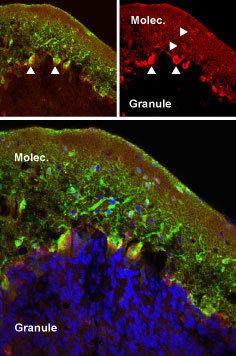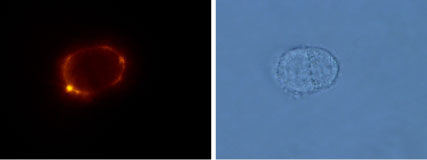Overview
- Peptide EGFAQENSKYNKTC, corresponding to amino acids 367-380 of rat mGluR5 (Accession P31424). Extracellular, N-terminus.

 Western blot analysis of rat brain membranes:1. Anti-mGluR5 (extracellular) Antibody (#AGC-007), (1:500).
Western blot analysis of rat brain membranes:1. Anti-mGluR5 (extracellular) Antibody (#AGC-007), (1:500).
2. Anti-mGluR5 (extracellular) Antibody, preincubated with mGluR5 (extracellular) Blocking Peptide (#BLP-GC007).- Human brain endothelial hCMEC/D3 cell lysate (Zuccolo, E. et al. (2019) J. Cell. Physiol. 234, 4540.).
 Expression of mGluR5 in rat cerebellumImmunohistochemical staining of perfusion-fixed frozen rat cerebellum sections using Anti-mGluR5 (extracellular) Antibody (#AGC-007), (1:50). mGluR5 (red) was detected in cerebellar Purkinje cells (vertical arrows) and in the molecular layer (horizontal arrows). Staining with mouse anti-parvalbumin (green) revealed co-localization in Purkinje but not in the molecular layer. Little staining of mGluR5 was detected in the granule layer. DAPI counterstain is used to visualize nuclei of all cells (blue).
Expression of mGluR5 in rat cerebellumImmunohistochemical staining of perfusion-fixed frozen rat cerebellum sections using Anti-mGluR5 (extracellular) Antibody (#AGC-007), (1:50). mGluR5 (red) was detected in cerebellar Purkinje cells (vertical arrows) and in the molecular layer (horizontal arrows). Staining with mouse anti-parvalbumin (green) revealed co-localization in Purkinje but not in the molecular layer. Little staining of mGluR5 was detected in the granule layer. DAPI counterstain is used to visualize nuclei of all cells (blue). Expression of mGluR5 in rat hippocampusImmunohistochemical staining of perfusion-fixed frozen rat hippocampus sections using Anti-mGluR5 (extracellular) Antibody (#AGC-007), (1:50). mGluR5 (red) was detected in CA3 cells (arrows). Staining with mouse anti-parvalbumin (green) revealed co-localization in pyramidal layer. DAPI counterstain was used to visualize nuclei of all cells (blue).
Expression of mGluR5 in rat hippocampusImmunohistochemical staining of perfusion-fixed frozen rat hippocampus sections using Anti-mGluR5 (extracellular) Antibody (#AGC-007), (1:50). mGluR5 (red) was detected in CA3 cells (arrows). Staining with mouse anti-parvalbumin (green) revealed co-localization in pyramidal layer. DAPI counterstain was used to visualize nuclei of all cells (blue).
- Kew, J.N.C. and Kemp, J.A. (2005) Psychopharmacology (Berl). 179, 4.
- Ferraguti, F. and Shigemoto, R. (2006) Cell Tissue Res. 326, 428.
- Dhami, G.K. and Ferguson, S.S.G. (2006) Pharmacol. Ther. 111, 260.
L-Glutamate, the major excitatory neurotransmitter in the central nervous system, operates through several receptors that are categorized as ionotropic (ligand-gated cation channels) or metabotropic (G-protein coupled receptors). The metabotropic glutamate receptors family includes eight members (mGluR1-8) that have been divided into three groups based on their sequence homology, pharmacology and signal transduction.
Group I of the metabotropic glutamate receptors includes the mGluR1 and mGluR5 receptors. The receptors present the typical G-protein coupled receptor (GPCR) signature topology: seven transmembrane domains with a large extracellular N-terminus domain and an intracellular C-terminus one. The N-terminus domain of group I receptors contains the glutamate binding site while the cytoplasmic C-terminus domain has an important role in the regulation of receptor activity through interactions with other proteins such as the Homer adaptor proteins.
mGluR1 and mGluR5 receptors signal through Gq/G11 that activates phospholipase C and ultimately produces an increase in inositol trisphosphate and cytosolic Ca2+. More downstream signaling pathways include activation of PKC and modulation of Ca2+ and K+ ion channels. Activation of signaling pathways independent of G-proteins has also been reported.
mGluR5 is predominantly expressed in nervous tissue although expression in several non-neural cell types has also been described. In the brain it is highly expressed in the cortex, basal ganglia and hippocampus.
The mGluR5 receptor is involved in several physiological processes such as neuronal development, induction of long-term potentiation (LTP) and depression (LTD) as well as in pathological disorders such as brain trauma, chronic pain, Parkinson’s and Huntington’s disease.
Application key:
Species reactivity key:
Anti-mGluR5 (extracellular) Antibody (#AGC-007) is a highly specific antibody directed against an extracelluar epitope of rat mGluR5. The antibody can be used in western blot, immunohistochemistry, live cell imaging, and indirect live cell flow cytometry applications. It has been designed to recognize mGluR5 from rat, mouse, and human samples.
Applications
Citations
- Human brain endothelial hCMEC/D3 cell lysate.
Zuccolo, E. et al. (2019) J. Cell. Physiol. 234, 4540.
- Rat astrocytes (1:100).
Shrivastava, A.N. et al. (2013) Glia 61, 1673.
- Arizono, M. et al. (2012) Sci. Signal 5, ra27.
- Ko, S.J. et al. (2012) J. Neurosci. 32, 16391.
- Chen, M. et al. (2011) J. Neurosci. 31, 9563.
- Krishnan, B. et al. (2011) PLoS One. 6, e25639.
- Schmidt, K. et al. (2011) Eur. J. Neurosci. 34, 177.
- Li, J-Q. et al. (2010) J. Neurochem. 112, 162.
- Renner, M. et al. (2010) Neuron 66, 739.


